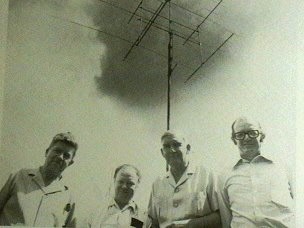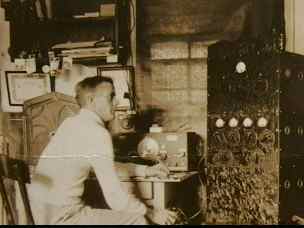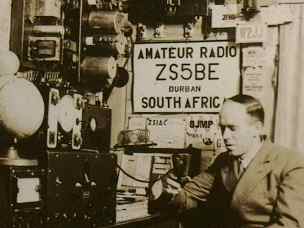| HomePage | Family | Images | OurHome | Norway | Australia (J) | Australia (M) | HamRadio |
|---|
|
SOUTH AFRICAN RADIO LEAGUE ANNUAL MARCONI DAY LECTURE - April 1996
BY: HANS VAN DE GROENENDAAL ZS5AKV*
INTRODUCTION It has become customary to present a special feature on the invention of Radio in the SARL's weekly Radio Programme "Amateur Radio Mirror International" on the Sunday following World Marconi Day. This year the day is celebrated on Saturday 20 April which is the nearest Saturday to Marconi's date of birth. Marconi was born on 25 April 1874. Each year the Marconi Day Lecture features a different person who, in his own right, has made a major contribution to the development of Radio. People like Maxwell, and Hertz have been featured in the past but in recent years the spotlight has fallen on South Africans who have made significant inputs to the development of radio. Names such as Alfred Jennings, Trevor Wadley and van de Bijl come to mind. In this year's feature the author has chosen to write about a person
still in the prime of his life, a person who we has decided to call the
"Living legend of Radio"
* Councillor South African Radio League
Executive Director: South African Amateur Radio Development Trust Member of IARU Region 1 Executive Committee P.O.Box 1842, Hillcrest 3650, South Africa Email: hans@igubu.saix.net Fax: 031 765-6456
DAVE LARSEN ZS6DN SOUTH AFRICA'S LIVING LEGEND OF RADIO Driving between Pretoria and Johannesburg, many a traveller is intrigued by a farm of antenna masts on the hill overlooking the main road to the Johannesburg International Airport. Turning off the main road down a narrow farm track one finds the sign "SALBU" the home, the office, the research laboratories of Dave Larsen ZS6DN, South Africa's living legend of radio. It all started on July 19th 1879 when after the untimely death of their father, Sivert Andersen, the three grandchildren of Anders Tollevsen Salbu left Norway on the Sailing Ship Debora and settled in Port Natal. Part of the mission of the Debora members was that "all would endeavour to create new economic activities". By the early 1900's the great-grandchildren of Anders Tollevsen Salbu, the cousins Johan Thorvaldsen (ZS5B), Gustav Larsen (ZS5DN) and Sivert "Wireless Windy" Larsen (ZS5BE) had established experimental radio stations. Windy's receiving station was licensed in 1924 and the transmitting station A7Q in April 1926, exactly 70 years ago to the day. David Victor Larsen was born in Durban on 15 September 1933 into a family which was steeped in the early history of radio in South Africa. In his early years Dave Larsen studied radio communication under Sivert Larsen, and whilst at school he ran a small business repairing receivers to bring in extra money to carry on research and development work at the family's experimental wireless station. At the age of 8 he was experimenting with electricity and at 11 he was building complete receivers. . Frustratingly he had to wait to the regulatory age of 18 before he could obtain an Amateur Radio licence. He was licensed as ZS5DN, the callsign of the late Gustav Larsen, a callsign that officially launched him into the world of amateur radio experimentation. Dave attended the Natal Technical High School and and at night he studied at the Natal Technical College where he soon obtained the highest technical qualifications in Electronics offered at the time. In 1952 Dave Larsen joined SMD, a small manufacturing company in Pinetown where he was apprenticed to Frank Hickman. With the support and encouragement of the founder and Managing Director of the company Horace Dainty ZS5HT, Dave started his more formal applied research work in communications techniques . The company was soon to be manufacturing a wide range of electronic products including domestic radio receivers, communications receivers and transmitters. By the time he had completed his apprenticeship in 1955, Dave had overtaken his mentors in electronic design technology and in 1957 was appointed Senior Design Engineer. At SMD all of of the early work was carried out using valves. By the mid 1950's the first solid state devices made their appearance. At the time a number of Radio Amateur developed an interest in Single Side Band communications techniques. Two of the South African SSB pioneers were Empty Wessels ZS6KD and Bill Meyer ZS6DW - both had a SSB transmissions running with home built equipment. Dave and his brother Roy ZS5QU became deeply involved in the building, deployment and testing of SSB equipment. They were joined by other Radio Amateurs including Ken Clayton ZS5GU, John Kohler, John McCoy, Des Irvin, Garnet Gould, Julian Bouttle, Oliver Pierce and others living in the Pinetown/Durban area. With the encouragement of Horace Dainty ZS5HT and his company SMD, Dave and this team developed a range of experimental SSB equipment using state of the art phasing and filter methods. By the late 1950's Dave was not only Works Manager running a factory with 500 employees, but was responsible for the design of all the new products for the company. During this period he designed and developed South Africa's first commercial solid state single sideband HF radio. The production versions of this SSB radio transceiver was sold in large numbers throughout Africa. In 1963, the communications section of the company, with a staff of three, became Racal-SMD and moved to Pretoria where it was soon to open its doors as Racal Electronics South Africa. Dave moved with Racal-SMD to Pretoria - he relocated the family owned Salbu Experimental Radio Station and continued research into the design techniques for utility HF broadband solid-state receivers and transmitters. This work led to the development of the world's first solid state broad band HF manpack transceiver. Versions of this transceiver were manufactured by his company, Racal Electronics in South Africa , England, the United States and in a number of other countries. Dave became Technical Director of the fledgling Racal Electronics South Africa in 1965. In 1972 he was appointed Managing Director of the same company that was by now employing over 1000 people. During the seventies Dave and his team evolved an HF frequency hopping system. The concept was initially rejected by the experts at the time. Some 15 years later the authoritive publication, Janes Defence weekly wrote in the 11 July 1987 edition : "Frequency hopping is probably the most popular spread spectrum technique. Claimed to have been pioneered in South Africa, it now appears in tactical equipment manufactured by most of the major international radio communication companies." On his 45th birthday, the 15 September 1978 Dave retired from Racal Electronics to concentrate on his private research activities at the family owned Salbu Experimental Radio Station and became involved in research work involving compound frequency hopping, PARROT Relay, meteor burst and thin line satellite communication systems. It is interesting to note that Dave's work in the field of spread spectrum communication also started in his Amateur Radio Shack. He investigated the sweeping of one of the local oscillators of an SSB transceiver over 15kHz of the spectrum and did the same at the receiving end. The system worked well on the bench, but using the 50 hertz mains as a time base presented problems as the electricity grid "phase constant" was eratic around the country. The whole idea was ahead of its time and could only be reconsidered as a commercial system when fast and stable frequency synthesizers became available many years later. The early "on air tests" of the HF synthesized frequency hopping the concepts were tested on the 40 metre band in co-operation with fellow radio amateur Tom Cockbain. Today HF frequency hopping spread spectrum system are in operation thanks to those early pioneering days of Dave and his Amateur Radio friends. In the mid 1980s Dave was joined by his son James who had graduated from the University of Natal and established an academic research team. The Salbu Research Group established definite parameters for and demonstrated working meteor burst and low cost "thin line" satellite communications systems. During the late 1980s Dave's younger sons, Gernot and Mark Larsen, both university graduates, joined the Salbu team. Funding was raised for a Meteor Burst Communications development project. The meteor burst communications research programme resulted in an internationally accredited computer model for meteor burst link analysis. Six of the junior scientists involved in this and associated projects received doctorates. The pioneering work in the field of Meteor Burst Communications of fellow radio amateurs Fred Anderson, Mike Bosch and others made a important contribution to this project. Over the past 70 years Salbu has developed, built, demonstrated and evaluated a range of innovative State-of-the-art multi-media wireless communication equipment and systems complete with supporting software. A far cry from the humble wireless shacks of the 1920's. Today the Salbu Experimental Radio Station is located on a 100 acre property between Johannesburg and Pretoria where life goes on undisturbed, like in the early days of wireless, but research and development achievements coming for Salbu continue to receive high acclaim, world-wide. His work is continuing and so is his interest in Amateur Radio. He has recently installed a 5 five band HF beacon as part of an international Amateur Radio propagation research programme. The new multi-band HF beacon is operational from Salbu replacing the 14100 kHz beacon of which Dave has been the custodian since the inception of the programme many years ago. The beacon operates on 14100, 18110, 21150, 24930 and 28200 kHz. In 1989 Dave Larsen ZS5DN was awarded the Order of the Star of South Africa Grand Officer in recognition of his contribution to electronics. Dave Larsen ZS5DN - a living legend in Radio. |
|
ZS6DN EXPERIMENTAL RADIO STATION Twelve pictures follow after this text - the images are loading now, please wait. |
| HomePage | Family | Images | OurHome | Norway | Australia (J) | Australia (M) | HamRadio |
|---|












